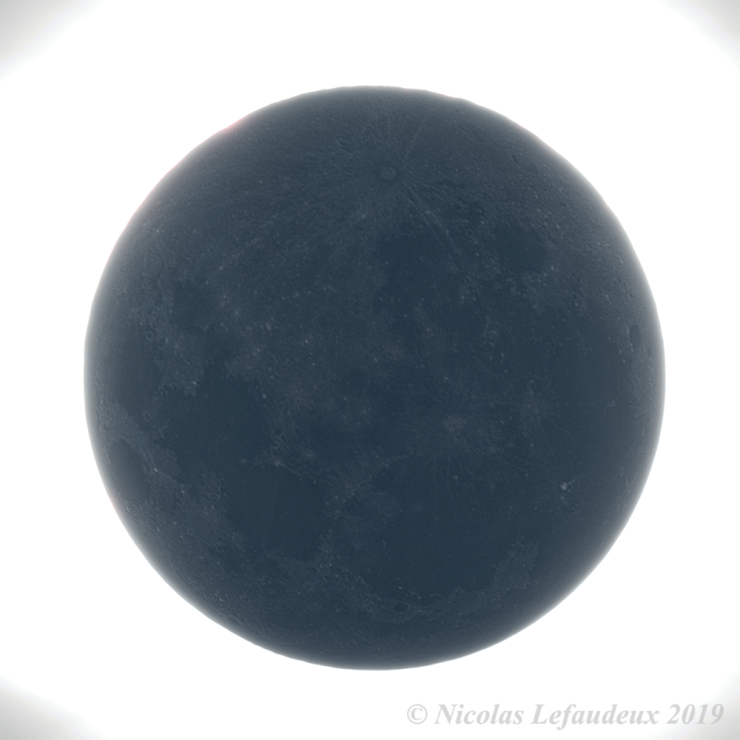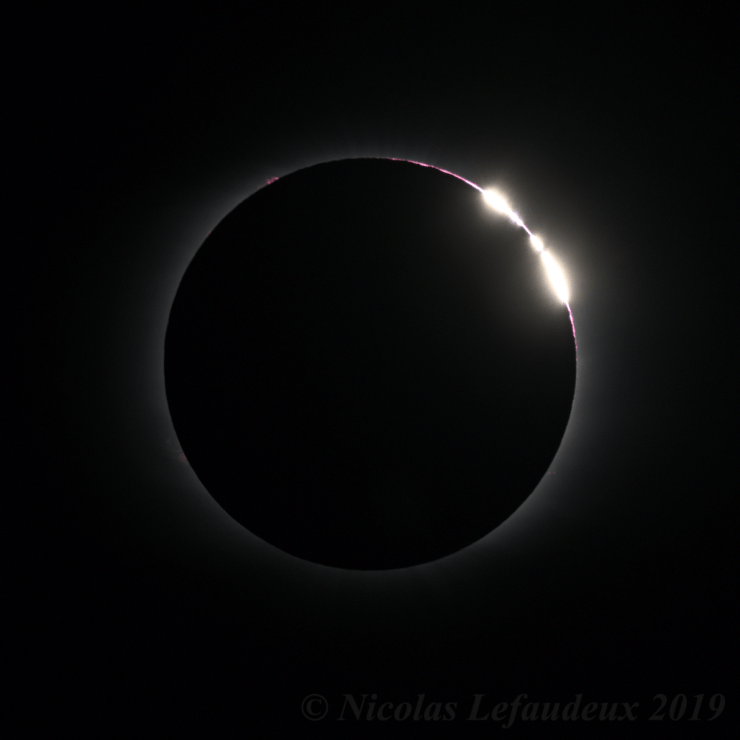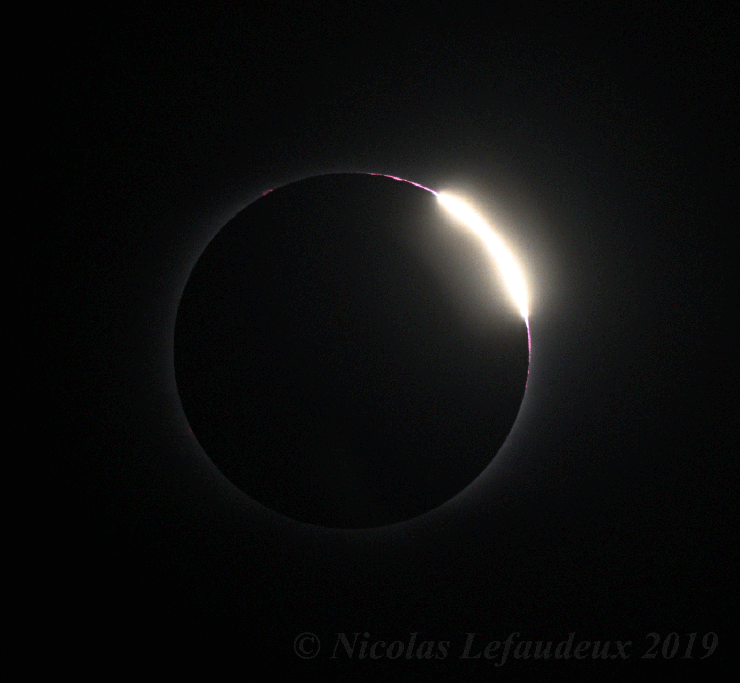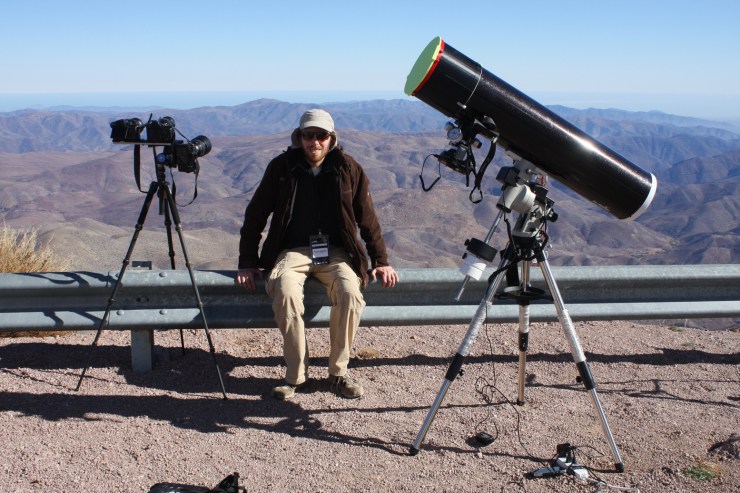I was fortunate to observed the eclipse from the Cerro Tololo Inter-American Observatory in Chile. The 2200m elevation of the observatory made the sky perfectly transparent there. The experience was really awesome with the perfectly clear view and great scenery of this unique location. The arrival of the Moon’s shadow was quite dramatic, and well recorded (see here) from this location.
The images were acquired with a 190mm Maksutov-Newton reflector. The camera body used was a Nikon Z7, which allowed 180 images to be acquired during the 124 seconds of totality thanks to the very fast write speed of its XQD card. The scope was equipped with a specific field corrector designed for this configuration.
Compared to the 2017 Eclipse for which i used a 100mm refractor and slow Sony A7RII, the combination of 190mm reflector + fast Nikon Z7 gathered 3x more photons and 2.5x more images. This gives a much better signal to noise ratio.
Going from 100mm to 190mm scope diameter should also have allowed a much finer resolution. Unfortunately, the seeing over most of the eclipse track was rather poor. This prevented obtaining very high resolution images. Still the excellent signal to noise ratio reveals a lot of coronal details as well as the many background stars.
 Composite 2019 Eclipse (high res here): the high signal to noise ratio shows a lot of details in the solar corona. The coronal structure is typical of solar minimum with polar plumes and equatorial extend of the corona.
Composite 2019 Eclipse (high res here): the high signal to noise ratio shows a lot of details in the solar corona. The coronal structure is typical of solar minimum with polar plumes and equatorial extend of the corona.
 Closeup view of the inner corona of the 2019 Eclipse (high res here) showing details of the coronal structures and prominences.
Closeup view of the inner corona of the 2019 Eclipse (high res here) showing details of the coronal structures and prominences.
 The excellent transparency and good contrast of the telescope allow to reveal details of the lunar surface on the Earthshine very close to the limb of the Moon (high res here).
The excellent transparency and good contrast of the telescope allow to reveal details of the lunar surface on the Earthshine very close to the limb of the Moon (high res here).
 The location of Cerro Tololo gave beautiful Baily’s beads at C2 (high res here).
The location of Cerro Tololo gave beautiful Baily’s beads at C2 (high res here).
 The high burst rate and write speed of Nikon Z7 allowed to capture the double Baily beads at C2 (open in full res here to avoid noise on some browsers).
The high burst rate and write speed of Nikon Z7 allowed to capture the double Baily beads at C2 (open in full res here to avoid noise on some browsers).
During the totality, the camera was driven in order to take successive sets of 9 exposures bracketed images. Exposure durations were 1/160s, 1/80s, 1/40s, 1/20s, 1/10s, 1/5s, 0.4s, 0.8s and 1.6s. Altogether, 14 successive 9-exposures-sets were acquired. Shorter exposures where used around C2 and C3 to get prominences and contacts.
Each successive 9-exposures-set of images was processed independently to get 14 successive HDR composites of the solar corona. The successive HDR composites were animated. Like in 2019, motions of the coronal structures are visible. The corona was overall much more still than in the 2017 eclipse.
 Animation showing the motion of coronal details. Some features of interest are highlighted with arrows. On top of these, the radial motions of some larger, low contrast features are visible. This is not artefact and might be caused by foreground coronal structures. For seeing best, open in larger size here.
Animation showing the motion of coronal details. Some features of interest are highlighted with arrows. On top of these, the radial motions of some larger, low contrast features are visible. This is not artefact and might be caused by foreground coronal structures. For seeing best, open in larger size here.
 Animation showing the motion of comparison between the solar corona of TSE2019 and TSE2017. The images have been normalized using the intensity gradient in the polar regions (which are the least dependent on solar activity) and processed identically. One can see the absence of streamers and absence of details above 1 Solar radius in TSE2019 while TSE2017 featured much more extensions. For seeing best, open in larger size here.
Animation showing the motion of comparison between the solar corona of TSE2019 and TSE2017. The images have been normalized using the intensity gradient in the polar regions (which are the least dependent on solar activity) and processed identically. One can see the absence of streamers and absence of details above 1 Solar radius in TSE2019 while TSE2017 featured much more extensions. For seeing best, open in larger size here.
 Closeup view of C2 at native resolution. Although the image is not perfectly sharp, one can notice the absence of instrumental chromatic aberration with the use of a reflector, and the absence of chromatic dispersion with the use of custom ADC to correct for the atmospheric dispersion at the 12° elevation of the eclipse (full res here)
Closeup view of C2 at native resolution. Although the image is not perfectly sharp, one can notice the absence of instrumental chromatic aberration with the use of a reflector, and the absence of chromatic dispersion with the use of custom ADC to correct for the atmospheric dispersion at the 12° elevation of the eclipse (full res here)
 Everything ready for the big day on the morning of July 2nd. For the French speaking, Astronogeek, who was part of the team of Ciel & Espace, has made videos of the totality and the preparation of the eclipse.
Everything ready for the big day on the morning of July 2nd. For the French speaking, Astronogeek, who was part of the team of Ciel & Espace, has made videos of the totality and the preparation of the eclipse.
Acknowledgments: Traveling to this eclipse and making these images have been possible thanks to:
- Astronomy Photographer of the Year Award, and everyone who ordered prints and reproduction of my images in books and calendars: the funds definitely made it possible for me to make this trip to Chile and to get a new scope for photographing the eclipse
- Mass-Vortex for the voluntary contribution
- Jean-Luc Dauvergne (Ciel & Espace), Shari Lifson and all the great team of CTIO and AURA for being part of Cerro Tololo guests and for help in logistical aspects (and adapters for US electrical outlets!)
- Nikon France for lending the camera bodies for photographing the eclipse
- Sinoptix for manufacturing the custom corrector and ADC for the telescope
- Nabila Meknoun for the support and help in carrying all the 35kg+ of gear by plane/car/bus/ feet !
Thanks everyone!